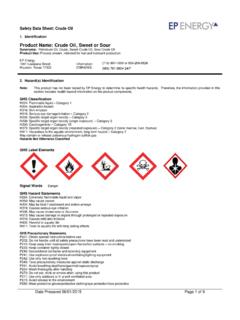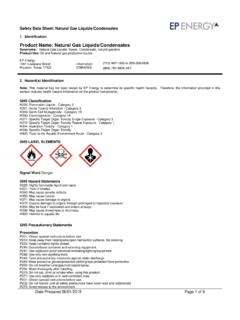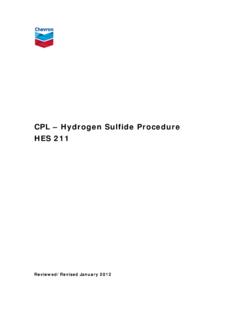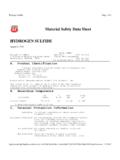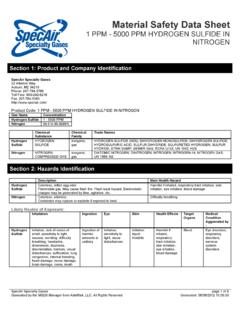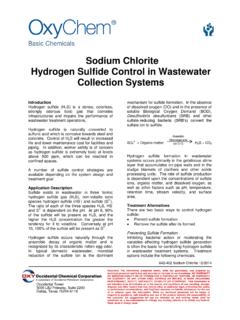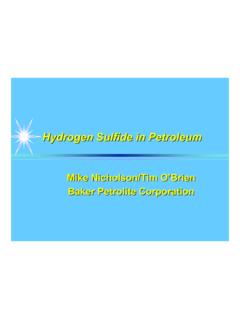Transcription of Safety Data Sheet: Hydrogen Sulfide
1 Safety Data Sheet: Hydrogen Sulfide 1. Identification Product Name: Hydrogen Sulfide MSDS Number: Synonyms: Sulfurreted Hydrogen , H2S, Stink Damp, Sulfur Hydride, Sewer Gas Product Use: Naturally occurring in crude petroleum and encountered during petroleum/natural gas exploration and production EP Energy 1001 Louisiana Street Information: (713) 997-1000 or 855-269-0826. Houston, Texas 77002 CHEMTREC: (800) 424-9300. 2. Hazard(s) Identification Note: This product has not been tested by EP Energy to determine its specific health hazards. Therefore, the information provided in this section includes health hazard information on the product components. Potential Health Effects from Overexposure: Acute Effects: Eyes: Highly irritating. May cause eye pain and an increased production of tears. Skin: None expected from contact with gas. Liquid may cause frostbite, but this exposure not expected.
2 Inhalation: CNS injury can be immediate and significant . Mucous membrane and respiratory tract irritant. High concentrations, even briefly, may cause dizziness, drowsiness, tremors, pulmonary edema, and death. Acts as a chemical asphyxiant by paralyzing the respiratory center. Lower concentrations will produce symptoms such as headache, dizziness, excitement, staggering gait, diarrhea and dysuria. Fibrogenic to the lungs following acute exposures complicated by bronchitis obliterans. Ingestion: Route of exposure unlikely to occur. Chronic Effects: Chronic low exposures may cause conjunctivitis, photophobia, bronchitis and headaches. Additional Medical and Toxicological Information: May aggravate pre-existing lung ailments, gastrointestinal, cardiovascular and nervous disorders. 3. Composition/Information Components CAS No. Wt%.
3 Hydrogen Sulfide 7783-06-4 100. Dangerous levels of H2S may be present during handling and storage of oil and gas products. 4. First-aid measures Eye Contact: Flush thoroughly with water for at least 15 minutes. If pain or redness persists, seek medical attention. Skin Contact: Skin contact unlikely to occur. Inhalation: If respiratory symptoms develop, move victim to fresh air. Seek immediate medical attention if symptoms persist. If breathing has stopped and airway is clear, provide artificial respiration. Seek immediate medical attention. Ingestion: Not applicable Medical Providers: Medical providers are urged to contact a Regional Poison Center at 800-222-1222. At high concentrations, Hydrogen Sulfide may produce pulmonary edema, respiratory depression, and/or respiratory paralysis. Date Prepared 08/01/2012 Page 1 of 5. Safety Data Sheet: Hydrogen Sulfide 5.
4 Fire-Fighting Measures Flammable Properties: Flash Point: Not applicable (gas). Flammable Limits in Air % by Vol.: Lower (LFL): 4 % Upper (UFL): 44 %. Auto-ignition Temperature: 500 F. NFPA Ratings: Health: 4 Flammability: 4 Reactivity: 0. General Fire Hazards: Highly flammable, toxic gas. Gas/air mixtures can be explosive. Ignited by heat, sparks or flames or other sources of ignition. May travel to sources of ignition and flashback. Static discharge may cause explosive ignition. Hazardous combustion/decomposition products may include sulfur dioxide. Extinguishing Media: Suitable extinguishing media: dry chemical, foam, carbon dioxide or water spray for small fires. Water spray or foam should be used for large fires. Unsuitable extinguishing media: none. Fire Fighting Instructions: Isolate area for at least 100 meters in all directions as an initial precaution.
5 Stay upwind. Keep out of low areas. Move containers from fire area if you can do it without risk. Use a water spray to cool fire-exposed containers until well after fire is out. Fight fire from maximum distance or use unmanned hose holders or monitor nozzles. Do not direct water at source of leak or Safety devices as icing may occur. Dike fire-control water for later disposal; do not scatter the material. Firefighters should wear self-contained breathing apparatus. Refer to Section 8 for proper PPE. selection. Maintain isolation of area until gas has dispersed. 6. Accidental Release Measures As an immediate precautionary measure, isolate spill or leak area for at least 1600 meters in all directions. Keep unauthorized personnel away. Stay upwind. Keep out of low areas. Ventilate closed spaces before re-entering. Stop gas and/or material flow.
6 Eliminate sources of heat or ignition, including internal combustion engines and power tools. If indoors, ventilate the affected area. All equipment must be grounded. Isolate area until gas has dispersed. Prevent spreading of vapors through sewers, ventilation systems and confined areas. For emergency information and procedures to follow in the case of an accidental release, call the Emergency Telephone Number(s) listed in Section 1. Use water spray to reduce vapors or divert vapor cloud drift. Provide sufficient ventilation in the affected area(s) and wear appropriate personal protective equipment as indicated in Section 8 when handling spill material. Wear self-contained breathing apparatus if conditions warrant. Clean up according to all applicable regulations. 7. Handling and Storage Dangerous levels of H2S may be present during handling and storage of oil and gas products.
7 Odor is not a good warning signal. Handling: Keep away from heat, sparks and open flame. No smoking. Use only with adequate ventilation. Use only with adequate ventilation. Wear appropriate personal protective equipment and use exposure controls as indicated in Section 8. Vent slowly to the atmosphere when opening. Avoid all contact with skin and eyes and avoid breathing gas. Use explosion-proof electrical (ventilating, lighting and material handling). equipment. Non-sparking tools should be used. Ground and bond all transfer and storage equipment. Use appropriate mitigating procedures. Do not enter confined spaces without following proper entry procedures. Storage: Keep away from flame, sparks, excessive temperatures and open flame. No smoking. Maintain vessels closed and clearly labeled. Empty vessels may contain explosive vapors.
8 Do not pressurize, cut, heat, weld or expose these vessels to sources of ignition. In a tank or other closed container, the vapor space may accumulate hazardous concentrations of H2S. Do not enter confined spaces without following proper entry procedures. Incompatibilities: Keep away from strong oxidizers, strong nitric acid, metals, ignition sources and heat. Date Prepared 08/01/2012 Page 2 of 5. Safety Data Sheet: Hydrogen Sulfide 8. Exposure Controls/Personal Protection Occupational Exposure Limits Components CAS No. Units OSHA(1) ACGIH(1) NIOSH(2). Hydrogen Sulfide 7783-06-4 20 Ceiling 15 STEL 10 Ceiling ppm (1). 8-hour TWA unless otherwise specified. (2). 10-hour TWA unless otherwise specified. STEL: 15-minute Short Term Exposure Limit Ceiling: Concentration not to be exceeded at any time Eye Protection: Safety glasses are required standard PPE.
9 Skin Protection: Fire Resistant Clothing (FRC) is required standard PPE. Inhalation: A NIOSH-approved respirator must be worn where controls do not maintain airborne concentrations below occupational exposure limits. Use approved positive-pressure supplied-air respirator or positive-pressure, full-face self-contained breathing apparatus (SCBA) protective equipment for entry into areas of unknown concentrations and to contain leaks, entry into tanks, vessels or other confined spaces or in situations where airborne concentrations may exceed occupational exposure levels. Engineering Controls: Provide adequate general and local ventilation to: (1) Maintain airborne chemical concentrations below applicable exposure limits, (2) Prevent accumulation of flammable vapors and formation of explosive atmospheres, and (3). Prevent formation of oxygen deficient atmospheres, especially in confined spaces.
10 9. Physical and chemical properties Appearance: Colorless gas % Volatile by Volume: 100. Odor: Rotten eggs Viscosity: Not available Boiling Point: -77 F Melting Point: -122 oF. Freezing Point: -122 F Vapor Density (Air = 1): Vapor Pressure: @ 77 oF pH: Not available Solubility in H2O: % Evaporation Rate: Specific Gravity @ 60 F & 1 Molecular Wt.: atm: 10. Stability and Reactivity Stability: Stable under normal conditions of use and normal temperature conditions. Hazardous Polymerization: Will not occur. Conditions to Avoid/Incompatibilities: Strong oxidizing agents, strong nitric acid and metals, heat, sparks, flame and build-up of static electricity. Hazardous Decomposition Products: Sulfur dioxide. 11. Toxicological Information Hydrogen Sulfide may be fatal if inhaled. Greater than 15-20 ppm continuous exposure can cause mucous membrane and respiratory tract irritation.
